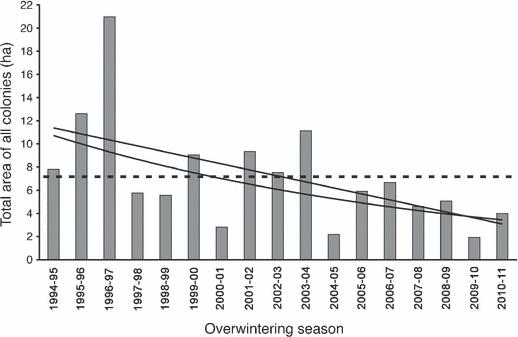Graph of the Day: Total Annual Area Occupied by Overwintering Monarch Butterflies, 1994-2011
The total annual area occupied by overwintering monarch butterflies from 1994 through 2011 has declined significantly, with the all-time smallest area reported during the 2009–10 overwintering season. The dashed line shows the 17-year average (7.24 ha). Both linear (upper) and exponential (lower) regression lines are included. Abstract: During the 2009–2010 overwintering season and following a 15-year downward trend, the total area in Mexico occupied by the eastern North American population of overwintering monarch butterflies reached an all-time low. Despite an increase, it remained low in 2010–2011. Although the data set is small, the decline in abundance is statistically significant using both linear and exponential regression models. Three factors appear to have contributed to reduce monarch abundance: degradation of the forest in the overwintering areas; the loss of breeding habitat in the United States due to the expansion of GM herbicide-resistant crops, with consequent loss of milkweed host plants, as well as continued land development; and severe weather. This decline calls into question the long-term survival of the monarchs’ migratory phenomenon.
Decline of monarch butterflies overwintering in Mexico: is the migratory phenomenon at risk?
